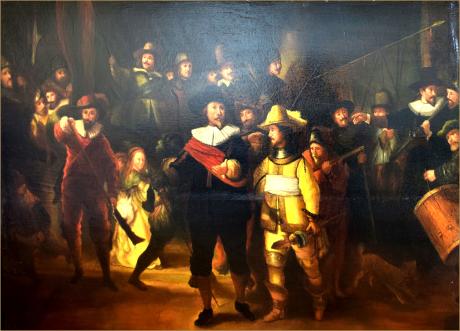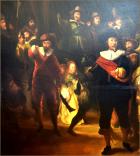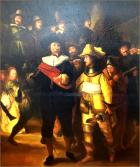Property of a Nobleman
In popular culture The Night Watch is probably regarded as currently the fourth most famous painting in the Western world, after the Mona Lisa, the Last Supper and the ceiling of the Sistine Chapel.
Militia Company of District II under the Command of Captain Frans Banninck Cocq,also known as The Shooting Company of Frans Banning Cocq and Willem van Ruytenburch, but commonly referred to as The Night Watch (Dutch: De Nachtwacht), is a 1642 painting by Rembrandt van Rijn. It is in the collection of the Amsterdam Museum but is prominently displayed in the Rijksmuseum as the best known painting in its collection. The Night Watch is one of the most famous Dutch Golden Age paintings.
The painting is famous for three things: its colossal size (363 cm × 437 cm (11.91 ft × 14.34 ft)), the dramatic use of light and shadow (tenebrism) and the perception of motion in what would have traditionally been a static military group portrait. The painting was completed in 1642, at the peak of the Dutch Golden Age. It depicts the eponymous company moving out, led by Captain Frans Banning Cocq (dressed in black, with a red sash) and his lieutenant, Willem van Ruytenburch (dressed in yellow, with a white sash). With effective use of sunlight and shade, Rembrandt leads the eye to the three most important characters among the crowd: the two gentlemen in the centre (from whom the painting gets its original title), and the woman in the centre-left background carrying a chicken. Behind them, the company's colours are carried by the ensign, Jan Visscher Cornelissen. The figures are almost life-size.
Rembrandt has displayed the traditional emblem of the arquebusiers in a natural way, with the woman in the background carrying the main symbols. She is a kind of mascot herself; the claws of a dead chicken on her belt represent the clauweniers (arquebusiers), the pistol behind the chicken represents clover and she is holding the militia's goblet. The man in front of her is wearing a helmet with an oak leaf, a traditional motif of the arquebusiers. The dead chicken is also meant to represent a defeated adversary. The colour yellow is often associated with victory.
For much of its existence, the painting was coated with a dark varnish, which gave the incorrect impression that it depicted a night scene, leading to the name by which it is now commonly known. This varnish was removed only in the 1940s.
In 1715, upon its removal from the Kloveniersdoelen to the Amsterdam Town Hall, the painting was trimmed on all four sides. This was done, presumably, to fit the painting between two columns and was a common practice before the 19th century. This alteration resulted in the loss of two characters on the left side of the painting, the top of the arch, the balustrade, and the edge of the step. This balustrade and step were key visual tools used by Rembrandt to give the painting a forward motion. A 17th-century copy of the painting by Gerrit Lundens at the National Gallery, London shows the original composition.
The painting was commissioned (around 1639) by Captain Banning Cocq and seventeen members of his Kloveniers (civic militia guards).[3] Eighteen names appear on a shield, painted circa 1715, in the centre right background, as the hired drummer was added to the painting for free.[4] A total of 34 characters appear in the painting. Rembrandt was paid 1,600 guilders for the painting (each person paid one hundred), a large sum at the time. This was one of a series of seven similar paintings of the militiamen (Dutch: Schuttersstuk) commissioned during that time from various artists.
The painting was commissioned to hang in the banquet hall of the newly built Kloveniersdoelen (Musketeers' Meeting Hall) in Amsterdam. Some have suggested that the occasion for Rembrandt's commission and the series of other commissions given to other artists was the visit of the French queen, Marie de Medici, in 1638. Even though she was escaping from her exile from France ordered by her son Louis XIII, the queen's arrival was met with great pageantry.
The Night Watch first hung in the Groote Zaal (Great Hall) or Amsterdam's Kloveniersdoelen. This structure currently houses the Doelen Hotel. In 1715, the painting was moved to the Amsterdam Town Hall, for which it was altered. When Napoleon occupied the Netherlands, the Town Hall became the Palace on the Dam and the magistrates moved the painting to the Trippenhuis of the family Trip. Napoleon ordered it returned, but after the occupation ended in 1813, the painting again moved to the Trippenhuis, which now housed the Dutch Academy of Sciences. It remained there until it moved to the new Rijksmuseum when its building was finished in 1885.
The Night Watch rolled around a cylinder inside a crate. The canvas would be stored in this condition throughout World War II.
The painting was removed from the museum in September 1939, at the onset of World War II. The canvas was detached from its frame and rolled around a cylinder. The rolled painting was stored in Radboud Castle in Medemblik, north of Amsterdam.[5] After the end of the war, the canvas was re-mounted, restored, and returned to its rightful place in the Rijksmuseum.
On 11 December 2003, The Night Watch was moved to a temporary location, due to a major refurbishment of the Rijksmuseum. The painting was detached from its frame, wrapped in stain-free paper, put into a wooden frame which was put into two sleeves, driven on a cart to its new destination, hoisted, and brought into its new home through a special slit.
While the refurbishment took place, The Night Watch could be viewed in its temporary location in the Philipsvleugel of the Rijksmuseum. When the refurbishment was finished in April 2013, the painting was returned to its original place in the Nachtwachtzaal (Room of the Night Watch).
A persistent misconception is that Rembrandt's decline in popularity was the result of negative public reception of the painting. The myth has even made its way into modern advertising; in 1967, KLM featured the painting in an advertisement that said, "See Night Watch, Rembrandt's spectacular 'failure' (that caused him to be) hooted... down the road to bankruptcy." The myth has no reasonable origin as there is no record of criticism of the painting in Rembrandt's lifetime, and Captain Cocq even commissioned a watercolor of it for his personal album.
It is more likely that the decline in the artist's popularity was not the result of reaction to any one painting but to a broader change in taste. During the 1640s, wealthy patrons began to prefer the bright colors and graceful manner that had been initiated by such painters as the Flemish portraitist Anthony van Dyck.
Maurice Merleau-Ponty refers to this work in his essay, Eye and Mind. He writes that "the spatiality of the captain lies at the meeting of two lines of sight that are incompossible with one another. Everyone with eyes has at some time or other witnessed this play of shadows, or something like it, and has been made by it to see a space and the things included therein."
The work has inspired musical works in both the classical and rock traditions, including the second movement of Gustav Mahler's 7th Symphony and Ayreon's "The Shooting Company of Captain Frans B. Cocq" from Universal Migrator Part 1: The Dream Sequencer. In King Crimson's song "The Night Watch", from the band's 1974 album Starless and Bible Black, lyricist Richard Palmer-James muses on the painting to capture a key period in Dutch history, when, after a long period of "Spanish Wars", the merchants and other members of the bourgeoisie can turn their lives inward and focus on the tangible results of their lives’ efforts. The song adopts a number of perspectives, including the primary subjects, the artist himself, and a modern viewer of the painting, and paints a mini-portrait of the emergence of the modern upper-middle class and the consumerist culture. However, the song presents this portrait with a deft touch, and while not fully approving, is sympathetic in tone.
Alexander Korda's 1936 biographical film Rembrandt depicts the painting, shown in error in its truncated form, as a failure at its completion, perceived as lampooning its outraged subjects.
In Jean-Luc Godard's 1982 film, Passion, The Night Watch is reenacted with live actors in an opening shot. Godard explicitly compares his film to Rembrandt's painting, describing them both as "full of holes and badly-filled spaces". He instructs the viewer not to focus on the overall composition, but to approach his film as one would a Rembrandt and "focus on the faces".
The Night Watch is a major plot device in the eponymous 1995 film, Night Watch, which focuses on the painting's theft.
The Night Watch is parodied on the British cover of Terry Pratchett's 2002 book by the same name. The cover illustrator, Paul Kidby, pays tribute to his predecessor Josh Kirby by placing him in the picture, in the position where Rembrandt is said to have painted himself. A copy of the original painting appears on the back cover of the book.
The Night Watch is the subject of a 2007 film by director Peter Greenaway called Nightwatching, in which the film posits a conspiracy within the musketeer regiment of Frans Banning Cocq and Willem van Ruytenburch, and suggests that Rembrandt may have immortalized a conspiracy theory using subtle allegory in his group portrait of the regiment, subverting what was to have been a highly prestigious commission for both painter and subject. His 2008 film Rembrandt's J'Accuse is a sequel or follow-on, and covers the same idea, using extremely detailed analysis of the compositional elements in the painting; in this Greenaway describes The Night Watch as (currently) the fourth most famous painting in the Western world, after the Mona Lisa, the Last Supper and the ceiling of the Sistine Chapel.
In 2006. The Night Watch inspired the literary work A Ronda da Noite by the famous Portuguese writer Agustina Bessa Luís.
The painting appears in episode 3 of season 2 of Netflix's Sense8.
Rembrandt Harmenszoon van Rijn was born in Leiden in the Netherlands in 1606. His father was a miller, comfortably off and able to send Rembrandt to the town's Latin School. At the age of 14, Rembrandt began studying at the famous University of Leiden (unusual for a miller's son), but academic life did not suit him. After a few months he left to begin an apprenticeship as a painter.
Leiden did not offer much in the way of artistic talent, and in 1624, after three years with a local painter, Rembrandt went to Amsterdam to study briefly with Pieter Lastman. He then moved back to Leiden and set up as an independent painter, sharing a workshop with Jan Lievens. It was not an easy climate in which to work. Following the Protestant Reformation, the local churches no longer provided artists with any commissions as the Catholic church did in other countries. As a consequence artists had to concentrate on commissions from private individuals. Rembrandt quickly began to make a name for himself as a painter of historical subjects.
Unusually, Rembrandt did not follow the advice that was given to young painters, namely to travel to Italy to study Italian art first hand. Instead he felt that he could learn everything he needed to from the art available in his native country.
In around 1631, Rembrandt moved to Amsterdam, the most prosperous port in northern Europe, and 'crowded with merchants from every nation'. It offered a young and successful artist far more opportunities than sleepy Leiden.
Rembrandt lodged in the house of an art dealer called Hendrick van Uylenburgh, and while there, he met his landlord's young cousin Saskia. They were married in 1634. The numerous paintings and drawings of her suggest the two were very happily married. In 1636, Saskia gave birth to their first son, Rumbartus. He died after only two weeks. Over the next four years two more children were born, but died within a couple of months.
Professionally, Rembrandt went from strength to strength. The most important families and organisations in the city commissioned paintings. As well as portraits, he produced baroque history paintings such as Belshazzar's Feast. Cash flow was sometimes a problem – and Rembrandt's cash flowed rather freely. He was a compulsive buyer of art, and a collector of all manner of antiquities, props, and weapons to be used in paintings. Saskia's family accused him of squandering her fortune. But Rembrandt was the most famous artist in the city.
Continued success
In 1639, Rembrandt and Saskia moved into a grander house, next to his old friend van Uylenburgh. He sketched endlessly - people on the street, beggars, circuses, women and children, Saskia. His painting was influenced by new developments in Italian art which reached the Netherlands via prints, and via his more travelled colleagues. Many of his contemporaries had started to experiment with the dramatic use of lighting developed by Caravaggio.
The influence of Caravaggio is evident in Rembrandt's work from the 1630s. He developed a new way of describing faces with patterns of light and shadow, rather than simply lighting one side and shading the other. Shadows around the eyes of his portraits, making it hard to read a precise expression give his canvases the extraordinary impression of the living, thinking mind behind the face.
In 1641 a fourth child, Titus, was born. And lived. Saskia was unwell after the birth and Rembrandt made various drawings of her looking tired and drawn in bed. In 1642, Saskia made a will leaving Rembrandt and Titus her fortune, although most of Rembrandt's share would be lost if he married. She died shortly after, still aged only 30, probably from plague or TB.
Domestic complications
Alone with a baby to care for, Rembrandt had to employ a nurse and took on a widow called Geertge Dircx. She became his common law wife for a short time, but then he took on another servant, Hendrickje Stoffels, and fell in love with her. Geertge took Rembrandt to court on the grounds that he had promised to marry her. He charged her with pawning some of Saskia's jewellery that she had left to Titus in her will. After much bitter wrangling, Rembrandt somehow had her sent to a house of correction. Meanwhile he and Hendrickje lived happily together, except that the terms of Saskia's will meant that he couldn't afford to marry her. She appears in numerous paintings, and may have been the model for A Woman Bathing.
One notable aspect of his later paintings is the use of broad brushstrokes, sometimes applied with a palette knife. While the earlier pictures had a smooth finish, the later works are designed to work only from a distance.
Bankruptcy
In the 1650s Amsterdam was hit by a massive economic depression. Rembrandt had not even completed half the payments on his house and his creditors began to chase him for money.
In July 1656, he successfully applied for 'cessio bonorum' - a respectable form of bankruptcy which avoided imprisonment. All his goods, including an impressive collection of paintings, were sold off for a pittance. Rembrandt, Titus and Hendkrickje moved across town to a much poorer district, where Rembrandt continued to paint. He had always used himself as a model, but in the last twenty years of his life he painted self portraits with increasing frequency. In 1663, Hendrickje died after a long illness. Titus was left to look after his father. Continued money problems forced them to sell Saskia's tomb, but still Rembrandt could not resist putting in an offer for a Holbein that came up for sale.
Titus married in 1668 the daughter of an old family friend, then seven months later, he died. A daughter, Titia, was born six months later. In 1669, Rembrandt himself died and was buried in the Westerkerk next to Hendrickje and Titus. There was no official notice of his death.



